Serviços Personalizados
Journal
Artigo
Indicadores
-
 Citado por SciELO
Citado por SciELO -
 Acessos
Acessos
Links relacionados
-
 Similares em
SciELO
Similares em
SciELO
Compartilhar
Anales del Instituto de Investigaciones Estéticas
versão impressa ISSN 0185-1276
An. Inst. Investig. Estét vol.33 no.98 Ciudad de México Nov. 2011
Artículos
Anthropology as Science, Anthropology as Politics: The Lessons of Franz Boas in Wolfgang Paalen's Amerindian Number of DYN
Antropología como ciencia, antropología como política: las lecciones de Franz Boas en el Amerindian Number de DYN de Wolfgang Paalen
Daniel Garza Usabiaga
Facultad de Filosofía y Letras, UNAM
* Artículo recibido el 19 de octubre de 2010;
aceptado el 3 de mayo de 2011.
Abstract
This article reviews the influence of the German anthropologist Franz Boas on the art and literature of Wolfgang Paalen, who edited the journal Dyn between 1942 and 1945. The publication featured a double issue (numbers 4-5) devoted to Amerindian art, to which various Mexican anthropologists, including Alfonso Caso and Miguel Covarrubias, contributed with their scientific findings. This essay also highlights the influence of Boas's ideas in these contributions. The idea of diffusionism is of particular importance, since it provides an explanation for similarities in the production of different cultures at considerable distances apart. Although Boas was always cautious about diffusionism, Paalen and the other contributors to Dyn (particularly Covarrubias) took a more radical approach. This was a strategy with clear political implications: radical diffusionism contradicted racist anthropological theories that were being used at the time to justify atrocities against basic human rights under the fascist dictatorial regimes in Europe.
Key words: Franz Boas; Wolfgang Paalen; DYN; Amerindian art; radical diffusionism.
Resumen
En este artículo se revisa la influencia que tuvo el antropólogo alemán Franz Boas en el arte y la literatura de Wolfgang Paalen, quien editó la revista DYN entre 1942 y 1945. Esta publicación presentó un número doble (4 y 5) dedicado al arte amerindio, en el cual diversos antropólogos mexicanos, como Alfonso Caso y Miguel Covarrubias, contribuyeron con sus descubrimientos científicos. En este artículo también se destaca la presencia de las ideas de Boas en estas contribuciones. La idea del difusionismo es de particular importancia, ya que permitió demostrar las similitudes en la producción de diferentes culturas separadas por una distancia considerable. Aunque Boas fue siempre cauteloso con respecto al difusionismo, Paalen y los otros colaboradores de Dyn, especialmente Covarrubias, tuvieron un enfoque radical. Esta estrategia tenía una clara implicación política: el difusionismo radical contradecía las teorías antropológicas racistas que, en esa época, justificaban las atrocidades contra los derechos humanos básicos bajo los regímenes dictatoriales fascistas en Europa.
Palabras clave: Franz Boas; Wolfgang Paalen; DYN; arte amerindio; difusionismo radical.
Franz Boas is widely recognized as a major influence on the work of Wolfgang Paalen, in particular in connection with his anthropological thought and his understanding of what was at the time referred to as Primitive Art.1 The Austrian painter, a former member of the Surrealist group, in exile in Mexico from 1939, took from Boas his cultural relativism and a conception of art "as a means of forming connections among peoples rather than increasing their distance."2 Moreover, just as Boas did, Paalen used anthropology as a science, as a means to fight prejudice and obscurantism, especially in the form of the prevailing evolutionist anthropological theories that were institutional in the West during the first half of the twentieth century. As is well known, evolutionist theories of this kind found their darkest moments under the fascist dictatorships of Europe, where anthropology was used to justify the most abject racism, one that went to the extremes of murder and extermination. The advancement of Boas' project in the work of Wolfgang Paalen is in line with his political intention to fight forms of totalitarian thought, something that was made explicit in the first number of his magazine DYN published between 1942 and 1944.
Although the impact of Boas' work on Paalen's oeuvre has been remarked upon on several occasions, it has not been highlighted in its totality so as to bring forth its political implications.3 Also, it has been overlooked that Paalen's interest in the work of Boas intensified after his arrival in the American continent and in particular in Mexico, where he found a group of anthropologists who were inspired by the ideas of the German scientist, a key figure in the development of modern anthropology in Mexico as well as in the United States. Proof of this influence can be found in the special double issue of dyn, the Amerindian Number (numbers 4 and 5), which can be read as a tribute to Boas, who died in 1942. The debt to Boas is evident here, in the use of anthropology as a science to combat the obscurantism of evolutionist thought, as well as in the understanding of Primitive Art as a weapon to create a new world consciousness, in line with the radical internationalism espoused by Surrealism.
The Amerindian Number appeared in 1943. It had contributions by leading Mexican anthropologists like Alfonso Caso and Miguel Covarrubias, the Peruvian poet César Moro, photographs by Eva Sulzer, Manuel Álvarez Bravo and Rosa Rolando, and Paalen himself with the texts "Totem Art," "Birth of Fire" and " Une visite au volcan." The intention of the present article is twofold. On the one hand it aims to illuminate Boasian ideas in Paalen's thought and work, in particular as regards this double issue of DYN. On the other hand, it also seeks to discuss the work of some of his local contributors, such as Covarrubias, Rolando and Álvarez Bravo, as well as to assess the impact that the Mexican cultural context might have had on Paalen's project and production. At the same time, the article seeks to unsettle an image that has been constructed of Paalen's exile in Mexico, according to which the figure of the artist seems to inhabit an ivory tower in San Angel, immune to the social and cultural context of the country. To address these concerns, it is first necessary to present the work of Franz Boas.
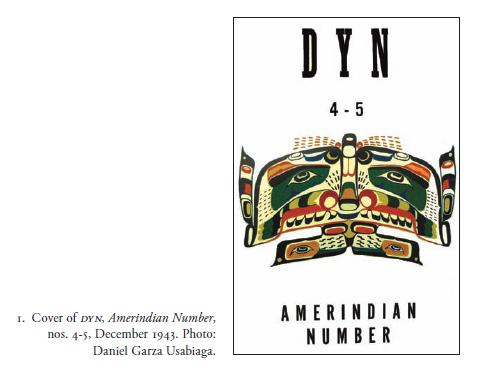
Franz Boas' anthropology and the work of Wolfgang Paalen
As is widely known, the work of Franz Boas was of primary importance in the discrediting of the evolutionary theories and other aberrations created by Social Darwinism and other conceptions of racial determinism. Born in Westphalia in 1858, Boas went to the United States in 1887 and worked there to establish a whole new approach to anthropology and the study of human culture. He created, amongst other things, an anthropological research program at Clark University and the Anthropology Department at Columbia; his participation was also crucial for the founding of the American Folklore Society and its publication: The Journal of American Folklore, which he edited for fifteen years. Interested in the study of the native cultures of Mexico since the final decade of the nineteenth century, Boas traveled to Mexico during the first ten years of the twentieth century and in 1912 became the Director of the International School of American Archeology and Ethnology in Mexico —an institution which he was fundamental in establishing.4 Upon his arrival in the country, Boas met the Mexican anthropologist Manuel Gamio, and together they embarked on several projects concerning archeological research and the articulation and study of the works of material culture found at the National Museum. In relation to this last task, they published the Album de colecciones arqueológicas the same year the International School was opened. It is impossible to underestimate the impact of Boas' ideas on the work of Gamio, although they ceased all collaborative work after 1923. As disciples of Gamio, it was through him that Miguel Covarrubias first became acquainted with the work of Boas.
Born into a progressive Jewish family, Boas found intolerable the theories of evolutionist anthropology, in use since the 1860s, which generally took the form of what has been called "scientific racism." In brief, this approach to human nature and culture makes the claim, refuted by Boas, "that humankind had evolved from lower primates in a series of phases which progressed from simple to more complex forms, culminating in the Caucasian race, the highest and to that point the most perfect product—the 'fittest'—of the sequence." Boas contended that a "corollary proposition held that as culture followed biology, the most primitive societies were the simplest, while the more highly evolved Western cultures were the most sophisticated and complex."5 Needless to say, this understanding justified, for long periods of time, acts of segregation, exploitation and extermination around the world. Through Boas' research—marked by an ethics in search of equality and freedom—the ideas of this "scientific racism" gradually became discredited and proved subsequently of vital importance for the disarticulation of the concept of race altogether. As Herbert Lewis has observed, Boas' approach to anthropology as science aimed at improving "the human condition by lessening the reign of the unknown and ignorance [...] and by decreasing the barriers and misunderstandings among peoples. He thought of anthropology as a tool with which to fight for the rights of the oppressed and the mistreated."6 Although today the work of Boas represents a kind of Copernican shift in the understanding of human culture, he did not live to see the abolition of the old racist scientific paradigm. During most of his professional career evolutionist anthropology was institutional knowledge across the Western world, including the Americas.7 Moreover, "scientific racism" was used to justify the atrocities of Fascism unleashed in Europe during the mid-1930s. Up to the day of his death, Boas fought the ideology of the National Socialist regime in Germany, which saw him as an enemy and never ceased to discredit his work in a most puerile manner. For instance, in a report of the German delegation that assisted to the 1939 International Conference of Anthropological and Ethnological Science in Copenhagen, it is stated that the "research of the Jew, Boas" was disavowed with proof of the German delegation, which "stated that on the basis of today's research results, there is no scientific justification to doubt the heredity also of mental capacity."8 The title of the paper presented by the leader of the group of scientists from Berlin was "Race and Inheritance of Mental Characteristics." It is impossible not to see in this kind of work an open attack on Boas' ideas which he had been developing since the 1890s, and which are contained in works such as The Mind of Primitive Man, published in 1911—that questioned racial determinism as a means to explain differences between cultures.
Evolutionist theories, Social Darwinism and racial determinism also gave direction to the study of art during the greater part of the first half of the twentieth century. Hence the term "primitive" applied to non-Western arts; "the implication, of course, was that the art of civilized peoples was superior in all ways to that of the 'savages.' "9 This racist conception of non-Western art is responsible for the increasing disuse of the term "Primitive Art," term which is nowadays often considered politically incorrect. Against this conception it is, however, important to revalue the notion of Primitive Art in a more productive manner. Exemplified in the work of several scientists, writers and artists, this category was more than just an ingredient to transform the Western aesthetic canon during the latter part of the nineteenth and the first half of the twentieth centuries. It was, rather, part of the articulation of a discourse that sought to question, dismantle and transform Eurocentric thought. The work of Franz Boas in this area is a case in point. His research on the subject of Primitive Art centered, on the whole, on the cultures of the United States and Canada, in particular, Alaska and the Northwestern Coast. Nevertheless, as seen in his book Primitive Art (1927), Boas constantly makes comparisons between these regional cultures with others of the continent, and with Asia, Europe and Oceania in order to bring forth similarities in cultural processes that pertain between different peoples of the world. Technical necessity, regularity of motor habits, esthetic impulse (feeling for form) and the universality of aesthetic experience, amongst other factors, are used to show what is common, instead of what is different, in mankind.10 The strategy aimed at subverting the categories of scientific racism, an attack that was made explicit in Boas's preface for Primitive Art, in which he emphatically states that "the mental processes of man are the same everywhere, regardless of race and culture, and regardless of the apparent absurdity of beliefs and customs."11
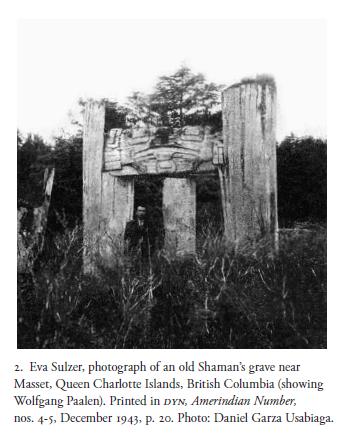
The impact of the work of Boas on Paalen's production became acute upon his arrival in the Americas, and there is no better place to assess this impact than in the Amerindian Number of DYN. However, Boas' influence and that of the works of the Northwest Coast permeate the other four issues of DYN as well as a number of paintings that Paalen produced between 1940 and 1942, published in the first three numbers of the magazine. As if following the steps of Boas upon his arrival in the continent, Paalen traveled to British Columbia in 1939 after a brief stay in New York. Even before he left Europe with Alice Rahon and Eva Sulzer he was fascinated by the cultures of the Northwest Coast. This is evidenced in his treatment of the figure of the totem in some of his paintings dated from 1937. This interest was expanded in "Paysage To-temique," a text recounting the trip to Canada, published in installments in different numbers of dyn, and illustrated with numerous photographs of totems, taken by Eva Sulzer. As Marie Mauzé has remarked, these photographs showed a culture in decline, a cultural landscape in ruins in which totems seem completely abandoned.12 Boas and Paalen shared the perspective that once these native cultures came into contact with Western culture, they became irreparably doomed. This does not imply a sort of "modernist nostalgia" in Paalen. As will be discussed, what he aimed at was a sort of actualization of the symbolic art of indigenous groups of the Americas "through a nearly cybernetic perspective."13
Under a more theoretical line, Boas' influence on the writings of Paalen can be appreciated in a text published in the second number of DYN titled "About the Origins of the Doric Column and the Guitar Woman." Part of this text compares the classical language of architecture, exemplified in the columns of the Parthenon, with the vernacular construction of British Columbia found in specific wooden structures in the village of Mamalilacoola. Following Boas' scientific strategy, Paalen made an analysis based on technical necessities in order to bring forth similarities between the two types of buildings and speculating a common origin:
The most ancient Greek temples were built of wood. It is well known that in the most diverse cultures, ritual objects and buildings, such as archaic temples of Crete and certain Mayan temples, originally made of wood were later repeated or transposed plastically in stone. Thus one may suppose that the fluting in the Doric column is a transposition in stone of the pattern of fluting resulting from the simple process of stripping bark with an adze off the trunk of a tree... In two cultures so far apart both in time and space, similarity of materials, tools, technics (sic), produced very similar patterns of fluting. In other words, this pattern can be explained purely functiona-listically (sic).14
If this case study is seen in relation to the totalitarian programme of National Socialism in Germany, the comparison acquires its full political import. As is known, the Nazi state favored a return to classical, particularly Greek, forms in art and architecture. The work of Albert Speer is emblematic of this tendency. The strategy by which this Classical referent becomes leveled with the cultures of North American Indians, regarded as "inferior races" under Nazi rule, thereby undermines the value system of German Fascism. The categorization within the Nazi regime of Amerindian cultures as inferior was widespread, as is evidenced in such textbooks as Races of the World. Moreover, any reference to Primitive Art was seen as a sign of degeneration in aesthetic practice. This can be appreciated through Otto Freundlich's sculpture Der neue Mensch (1912) selected by the Nazis to publicize the exhibition Entartete Kunst in 1937.15
The Amerindian Number
Paalen was to advance this kind of analysis, of Boasian inspiration, in the Amerindian Number of DYN. For this publication he found like-minded anthropologists and artists, such as Miguel Covarrubias who was also an advisor for the double issue.16 This special number attests to the fundamental place held by the cultures of the Americas in Paalen's production and in the project of the journal DYN in particular. Since the first number of the magazine, Paalen had made manifest his break with André Breton and the Parisian group of Surrealists through his text "Farewell au Surréalisme," in which he criticized their tendency to poeticize reality, a tendency that he felt could lead to obscurantism. The enthusiasm with which the DYN project embraced the cultures of the Americas differentiated it from Breton's work during his exile in New York around the magazine VVV, also launched in 1942. In the words of Eva Sulzer, it is possible to think that the aim of DYN was no less than to integrate "the vast scattered treasures of the Amerindian world" into the "esthetic consciousness," a task that had already been undertaken by Goncourt, Manet and Van Gogh in relation to the Far East, Picasso and the Expressionists with the art of Africa, and Surrealism with works from Oceania.17 In relation to the contents of vvv, Paalen commented that, as seen through this publication, the Surrealists had been "incapable of assimilating what there is of importance in American thought."18 Paalen's continuing critique of Surrealism took place with the use of anthropology as science. As Amy Winter mentions, Paalen's studies of cultures from the Americas were meant to dispel the excesses in poetic interpretation carried out by Breton and other surrealists.19 This use of anthropology can also apply to a critique of some features of Georges Bataille's work as evidenced by certain articles in Documents and his text "L'Amérique disparue."20 What makes the Amerindian Number unique as a publication is that it presented a whole collection of texts based on anthropological and historical research, something totally absent from previous periodicals in which the Surrealists were involved. The only exception to this would be Michel Leiris' and Marcel Griaulle's articles on the Dakar Djibouti expedition published in Documents and Minotaure during the first half of the 1930s.21
Some of these ideas were contained in the preface written for the Amerindian Number. For example, in this text it is stated that the intention of the magazine is to integrate "Amerindian forms into the consciousness of modern art."22 This integration was understood as the "negation of all exoticism," an approach that ran against the grain of most Surrealist interpretations. For Paalen, this "exoticism" also included works that searched for the "picturesquely local," motivated and "preserved through intellectual provincialism." It is impossible not to see in these comments a critique of the hegemonic aesthetic paradigm at work in Mexico during that time, a style of representation that was realist and utterly nationalistic, exemplified in a paradigmatic way by the Muralist movement. In a great number of these works, Pre-hispanic material culture was represented in its actual form, as literal reference, in order to sustain a narrative discourse contained in the work, a discourse written in nationalistic code. In contrast to this, and as can be gathered from what is written in this preface, the study of the material culture of the peoples of the Americas could provide, in Paalen's perspective, a new art reunited with the past; memories that could give direction to a "new image": an "art that often prefigures what might be." This kind of integration can be appreciated in three paintings that Paalen produced after his trip to Canada. Two of these included Figure pandynamique (1940) and Personnage spatial (1941), which appeared in the first and third issues of DYN respectively. The anthropomorphic reference in their titles has lead some to see certain elements in the paintings as the features of a face, such as eyes and mouths. Gavin Parkinson, for example, has described Figure pandynamique as through the lens of modern physics, suggesting, within the representation of particles and waves, the appearance of a "ghostly face."23 Besides this reading, it is possible to see a connection between these features of a face with the inclined anthropomorphic and zoomorphic designs of tlakwa and chilkat blankets of the Kwakiutl and Haida from British Columbia, with their curved lines, circular features and complete disregard for perspectival representation.24 Perhaps this reference is made the more explicit in a third of Paalen's paintings also reproduced in the first number of the magazine What the Sailor Will Say (1942). Although this work was signed by John Dawson, this name was one of the several aliases used by Paalen to make contributions to his own review while giving an impression of a burgeoning movement.
As remarked in the preface, this integration was not limited to the plastic qualities of the Amerindian works, but also comprehends "all those human possibilities hinted at throughout the ages, so often abandoned, refound, and lost again."25 In this way, Paalen's project is similar to that of Boas in his use of Primitive Art as an alternative to and critique of the value systems of the "civilized" world. This approach is evident in "Totem Art," Paalen's main contribution to the Amerindian Number. Following the strategy of his analysis on the Doric column, Paalen relied in this essay on the Totem pole to create connections between different cultures—European, Asian, African and Oceanic in origin—through the ages. The study proposes "mythological conceptions" as an element that can "achieve rather similar plastic expression without the intervention of any direct influence" between different cultures like those in the Northwest coast and the Mayan.26 Such comparisons are illustrated in DYN by way of photography. Most of the photographs taken ex professo to accompany this text, mostly shot by Manuel Álvarez Bravo, seem "scientific" in character: "Set off against a dark backdrop, frontally and evenly lit, photographed close-up at eye level and tightly cropped."27 The only photograph by Álvarez Bravo that seems to unsettle this character is an image of a Kwakiutl mask of Tsono-qoa, "a female cannibalistic spirit of the forest." The framing of the mask appears decentered and almost out of proportion, and the contrast of the wooden object with the white background gives this photograph an eerie effect. Although most of the photographs in this article cannot be qualified as Surrealist in character, Paalen relied on a tactic used in former publications of the collective in which the images are juxtaposed in order to undermine cultural values and general expectations. The photographs employed for this use have the strength of scientific rigor. This strategy was put to play in the Amerindian Number in the service of an anthropological approach that seeks to discover similarities between cultures set apart; that is, against the hegemonic evolutionist theories of that time. A photographic exercise of this kind is found at the end of Paalen's "Totem Art" and before Gustav Regler's contribution "Those Hunting Grounds." Representations of allegories of birth, found from British Columbia to the south of Mexico, are brought forth to show their similarities and connections. The aim of this tactic within Paalen's program was to contribute, in a very Boasian way, to a New World consciousness, highlighting commonalities and reducing differences between peoples.
Although it is possible to attest in "Totem Art" that Paalen equated "to-temic mentality" with the psychology of the infant, this does not justify the claim that he was trapped in the evolutionist theories of his time and even less so to frame him within "a colonialist tradition" whilst debasing his entire collecting activity with allegations that characterize him as a thief and looter of antiquities.28 As mentioned, Paalen's reliance on the work of Boas continued a project which aimed, no less, at the scientific discrediting of such racist ideas; whilst, on the other hand, his stance was always, following the best Surrealist tradition, anti-colonialist. This can be seen in his open condemnation of the laws banning festivities, such as the Potlatch, imposed by the Canadian government:
The wider public is not aware of the fact that in this region no important manifestation of indigenous life is tolerated, that in spite of the intervention in favor of the Indians by one of the greatest anthropologists (by Franz Boas), the yearly ceremonial festivals which formed the nucleus of the social life of these tribes are strictly forbidden.29
In Paalen's critique, colonialism carried an instrumentalism that went hand in hand with mercantilism: "The destruction of the social organization that created this art limits the 'creative power' of the peoples to decorative tasks and to create products for the souvenir market, trifles."30 In addition, one must take into account Paalen's anti-religious critique, as elaborated in "Totem Art." His stance against Christianity, another Surrealist posture par excellence, is reflected in his description of this religion—in contrast with that of the American cultures, as "anti-cosmic," "isolating man and his god in the universe" and as not tolerating "totemic survivals except in fairy tales and armorial bearings."31 For Paalen the transformation of the totemic mentality into "the personage of a powerful god" moved "according to a process of centralization of the idea of power which goes hand in hand with a progressive centralization of political power."32 It is, perhaps, within this critique that Paalen's appreciation of the failure of religion can be located which, in his view, had left art as the only alternative to creating a new humanism.
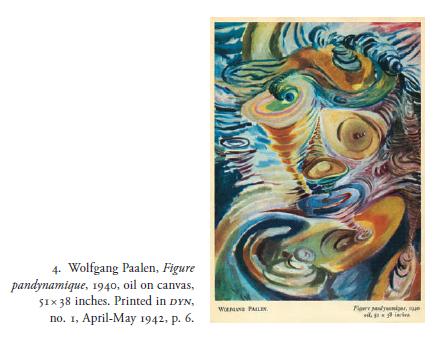
The influence of the work of Franz Boas is also found in other contributions to the Amerindian Number. For instance, Carlos Margain Araujo in his article "The Painting in Mexican Codices," discusses the limits imposed upon the artist by the weight of tradition, a line of argument developed by Boas as well in Primitive Art, wherein he writes of the "limitations which are very often insuperable for the free expansion and expression of the imagination of the artist."33 Also in this text, Margain speculated upon certain transcultural connections between the cultures of America and other continents, such as the Mixtec with the Egyptian, "among whom similar characteristics of expression can be observed."34 Scientific articles such as this were published by Paalen to counteract excessive interpretations of Amerindian peoples by the European avant-garde. In his rejection of all exoticism, this article on Mexican codices—in which it is stated that the Bourbonic Codex is the only one that can be regarded as Aztec—and the essays written by Maud Worcester Makemson and Miguel Angel Fernandez on Mayan culture, and César Moro's piece on Machu Picchu, give a scientific reading that goes against the grain of Georges Bataille's interpretation of these cultures, colored by the idées fixes which, according to Walter Benjamin, characterized his production.35 As a disciple of Manuel Gamio, Miguel Covarrubias was under the influence of Boas' ideas even before he became acquainted with Paalen and befriended him. This is something that can be appreciated in his anthropological writings, in the connections drawn between Bali and Tehuantepec, for instance, but also in his paintings. This is evidenced, with particular emphasis, in one of the murals that he painted for the San Francisco Golden Gate International Exposition (1939-1940). Native Dwellings of the Pacific Area relies on vernacular construction to bring forth similarities between different cultures on both sides of the Pacific Ocean. As can be surmised from his work, Covarrubias supported ideas of a radical diffusionism based on trans-Pacific contact, theories developed since the early 1920s by anthropologists like Leonard Adam.36 These diffusionist ideas were based on the possibility that migration across the Pacific took place despite the uncertainty as to how the movement of people occurred. These ideas were also espoused by the editor of dyn, as it can be appreciated in the review that Paalen wrote for Paul Rivet's book Les Origines de l'homme américain (1942) and in an article he wrote for Cahiers d'Art in 1952 in which he criticized those who "judge as arbitrary the comparative analysis of the symbolic art of races that are distanced in their location."37 Although scientific in their aims, anthropological theories such as this radical diffusion-ism were used by some authors to highlight their political implications. Rivet, for example, thought that these ideas could exalt and fortify a much needed human solidarity: "Every man should understand and know, that in all latitudes and in all the longitudes, other human beings, whatever the color of their skins or the form of their hair might be, have contributed toward making life sweeter and easier for him."38
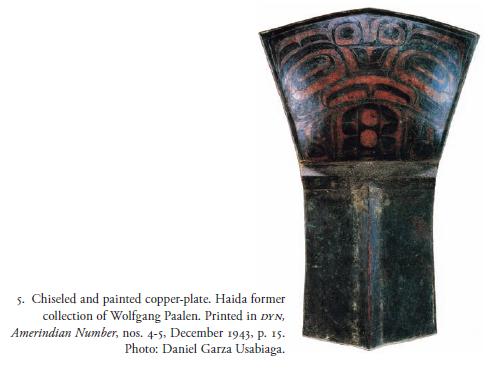
Miguel Covarrubias' contribution to the Amerindian Number was the article "Tlatilco. Archaic Mexican Art and Culture."39 In this text Covarrubias reports on the findings of an archaic culture of the Valley of Mexico, dating before the advent of Christianity. To show a fully developed culture at a time referred to in Europe as "Prehistory" could be seen as an attempt to unsettle the whole value system of the West based on the evolutionary theories of the epoch. The article also sought, through visual presentation, to establish similarities between the design of a claw in a little pot from Tlatilco with a claw represented in a chilkat blanket of the cultures of the Northwest Coast. This approach to transcultural studies, drawn from Boas, is also evidenced in Covarrubias' insertion in the sixth number of DYN "La Venta. Colossal Heads and Jaguar Gods."40 This article is a small part of his book Mexico South. The Isthmus of Tehuantepec published in 1946. Just as in his article on Tlatilco, this contribution is illustrated with his drawings and watercolors in a style that, although connected with the forms of caricature, aspired to scientific rigor. Radical diffusionist theories on trans-Pacific contact are put forward in this study, as can be appreciated in the illustration on page 2I where four jade objects in the style of La Venta are juxtaposed with the drawing of a Chinese sphinx-like demon. The article also contains a pair of photographs, illustrating four stone carvings of different animals of the Chumash of California, which show some formal connections with the art of La Venta. Two photographs that appear in the Amerindian Number, taken by Covarrubias' wife, the painter, photographer and designer Rosa Rolando, are related to this article in the sixth number of dyn, as they form part of the visual material of Mexico South. Within the special double issue, these photographs by Rolando are striking as they are the only images that are centered on portraying individuals more than anthropological objects. One of these photographs depicts three Chontal children, whilst the other is of a schoolgirl from Tehuantepec. These images contrast, for example, with the photographs of Eva Sulzer taken in British Columbia, in which totem poles seem abandoned and decayed, as if representing a culture in ruins. Of special interest is the photograph of the schoolgirl—posing in an almost military fashion—carrying a free book given by the Ministry of Education (Secretaría de Educación Pública, sep) under its program of socialist education. When Paalen arrived in Mexico the country still enjoyed what could be defined as a progressive post-revolutionary government. Under the regime of Lázaro Cárdenas, the Constitution was modified in matters of education in order to make it socialist: it absolutely rejected religious indoctrination and aimed at fighting fanaticism and prejudices, whilst creating a true human solidarity and the progressive socialization of the means of production. With its framing and angle, Rolando's image remits to the work of the European avant-garde in photography, the Russian Constructivists for example, who developed strategies that were later employed for political propaganda. The photograph recalls images such as El Lissitzky's exhibition poster for the Russian Exhibition (1929) in Germany, which depicted a composite head of a young man and a young woman looking ahead towards the future. With her posture and her grasp of the book as if it were a weapon, the girl of Tehuantepec has the same forward-looking gesture.41 As such, this photograph seems promising and hopeful, in striking contrast to the representation of other cultures of the Americas in decline as they appear in the Amerindian Number.
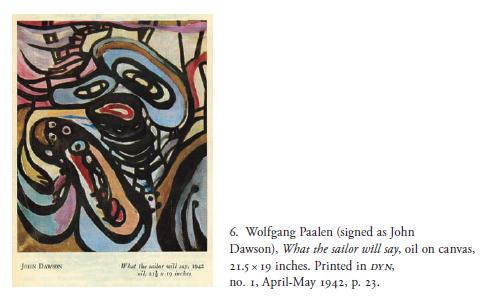
"Birth of Fire" and "Une visite au volcan" are Paalen's last contributions to the Amerindian Number of DYN. Here the cultures of the Americas, specifically of Mexico, are discussed by way of geology and the local landscape. On February 20, 1943, a new volcano emerged in the state of Michoacán, in the small community of Parangaricutiro, not far from El Molino, the residence of Gordon Onslow Ford and Jacqueline Johnson whilst living in Mexico. The Paricutín, as the new volcano was named, had a tremendous impact on Mexican culture, a fact that has rarely been remarked upon. The eruption of this volcano was something that left traces in the works of various artists such as Paalen, Johnson, Onslow Ford, Roberto Matta and the art critic Florence Arquin who settled in Mexico in the 1940s with the intention of becoming a painter.42 Within the local context of the country, the Paricutín reinvigorated a discourse that joined nationalism and landscape, specifically through the volcanoes Popocatépetl and Iztaccíhuatl in the valley of Mexico. This logic is emblematized in José María Velasco's works where landscape, mountains and volcanoes are often presented as allegories of Mexico featuring national symbols, religious edifices and aspects of technological progress.43 A case in point of the latter is El Citlaltépetl (1897) also known as Cañada de Metlac. In this painting Velasco brings together the volcano Citlaltépetl (also know as the Pico de Orizaba) and the bridge structure carrying the railroad over the ravine of Metlac—considered one of the greatest feats of civil engineering and iron construction of the nineteenth century not only in Mexico but worldwide.44 From 1943, the new volcano gave new strength to such discourse, something that can be appreciated in the paintings of Gerardo Murillo (Dr. Atl), and in Diego Rivera's work, particularly in his writings related to the mural he executed for the Olympic Stadium at the University Campus.45 Making explicit the resonance established between the architecture of the stadium and the local landscape, Rivera described this building, inaugurated in 1954, as an architectural crater made by an eruption, and equated this geological phenomenon with the Mexican Revolution.46 Moreover, through the nine years that the Paricutín was active, it became some sort of spectacle and tourist attraction, something that Paalen seemed to lament, especially in the last lines of "Une visite au volcan."47 A similar criticism can be found in a painting of Alfredo Zalce (El Paricutín, 1949) in which tourists attend the spectacle of the volcano, indifferent to the presence and distress of the locals, whilst Rivera and Dr. Atl try to sell them their paintings.
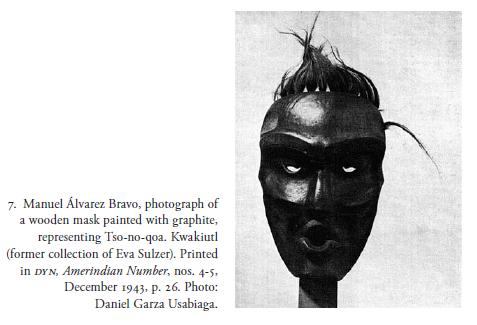
It is against the grain of these narrow and limited understandings of the phenomenon of the eruption of the volcano that Paalen's texts need to be read. Paalen was always fascinated by the geology of Mexico: he described the landscape as having an "asteroid quality" situating the Paricutín at its apex.48 As such, he formulated a hypothesis around this natural event, namely that the Mexican pyramid might be the mythological representation of the volcano. Paalen makes this relation clear by juxtaposing two photographs, one of the Pyramid of the Sun in Teotihuacán and other of the Paricutín, taken by Jacqueline Johnson. Paalen thus developed a theme, in which geography becomes symbolic, and wherein physical spaces become geometric archetypes that function as forms carrying symbols. Notably, this theme was later to be expanded by Octavio Paz in texts such as "Crítica a la pirámide" (1970).49 This comparison between the pyramid of the sun and the new volcano carried an intention that was Boasian in character: to bring together foundational myths from different cultures which "seek their first fire from volcanoes" in order to level them and find their connections. In this case Paalen offers a new interpretation of the Greek myth of Prometheus in order "to reveal, by analogy, the significance" of a Toltec myth described in detail in Miguel Ángel Fernández's contribution to the Amerindian Number, titled "New Discoveries in the Temple of the Sun in Palenque."50 The search for symbols that could be seen as collective or universal—even recalling the work of Carl Jung—seems to be central to Paalen's project for a "new humanism" to amend the failure of religion: or what Paalen criticizes openly in "Birth of Fire" as a debased form of Christianity.51 As this essay has sought to make clear, Paalen searched for similarities between different cultures through an anthropological approach that was, largely, indebted to the ideas of Franz Boas. This extends beyond methodology. Paalen and Boas' use of anthropology as science was aimed at debunking a hegemonic "scientific racism" that had justified the atrocities of the totalitarian dictatorships of Europe during the first half of the twentieth century, in particular Nazism. As such, their practice reveals a clear political intention.
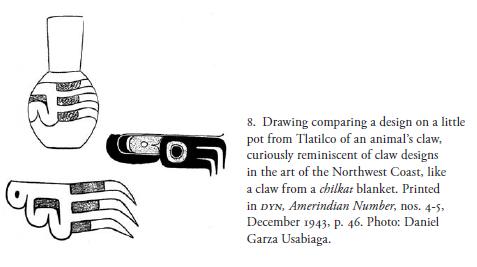
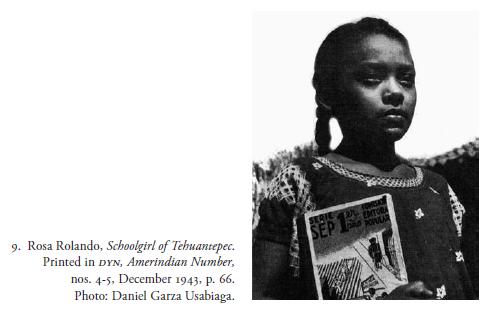
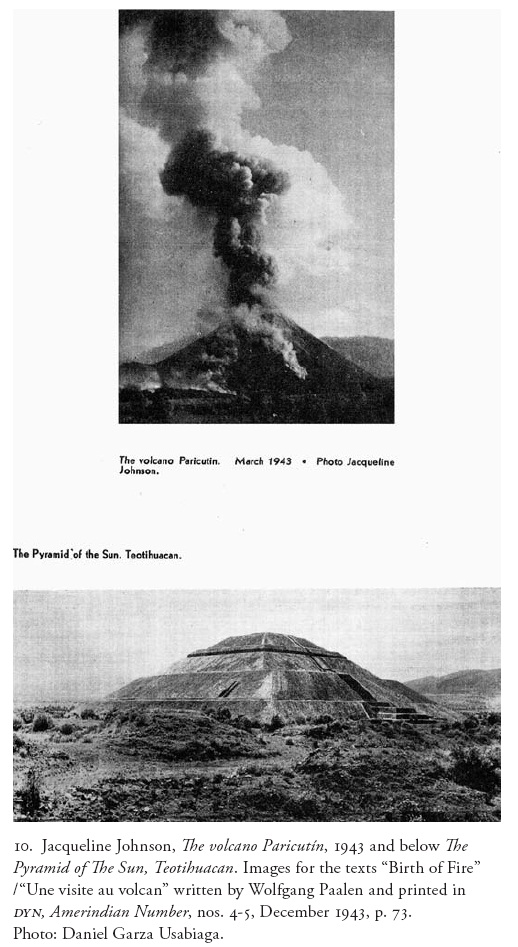
Conclusion
Along with this Boasian political strategy, the embrace of so-called Primitive Art by Paalen was integral in the formulation of a new world consciousness which advanced Surrealism's quest for a radical fraternal internationalism. Although at play through the whole history of Surrealism, this motivation became accentuated during and after the experience of exile. Breton's full embrace of the thought of Charles Fourier is expressive of this condition as well as his intentions to establish a "universal history" to counter national histories and his visualization of what he hoped would soon become the "United States of the World."52 The promotion of understanding and sympathy towards all cultures—put forward in dyn, particularly in its Amerindian Number—projects this aspiration towards a new universalism.
In spite of the fact that Paalen's proposal for new art was once described as rejecting memory and the past, there are several contradictions in his writings regarding his interest in Primitive Art and its impact on a work. Even if in "The New Image" Paalen described as one of its characteristics a connection with "the imagination and thus to the future," in the Amerindian Number he speaks of an art that can connect us to the past and all the human possibilities that it entailed.53 Primitive and ancient art are not approached as an "archaizing or copying of a blindly adored idol, but as a re-creating in face of the true forms of early art."54 That is, as formative elements, a vast reservoir of collective symbols and myths that, as César Moro put it, "dampen the wings of the ferocious eyelids of the imagination."55 This reflection on the works of Amerindian cultures in order to give form to his own paintings can be attested throughout Paalen's production after he settled in Mexico at the end of the 1930s. As mentioned, paintings such as Figure pandynamique and Personnage spatial seem to reconcile wave and particle formations (taken from the domain of modern physics) with the symbolic art of native groups of British Columbia (Primitive Art). This joining of physics and anthropology might be expressive of what Paalen called the memory of the future which makes it "possible to think that past and future touch each other as the parallels (within infinitesimal calculus) a fact made possible thanks to the physics and mathematics of the last century."56 This reconciliation testifies, as well, to the originality in his work which consisted in assimilating and expressing "a great variety of things in an always personal way."57 Art and science are, for instance, two recurrent elements in this great variety of things. Throughout this essay the intention has been to expand the notion of "science" in Paalen's work, limited generally to physics, by way of anthropology.
1. See Marie Mauzé, "Totemic Landscapes and Vanishing Cultures Through the Eyes of Wolfgang Paalen and Kurt Seligmann," Journal of Surrealism and the Americas, vol. 2, no. 1, 2008; [ Links ] Keith Jordan, "Surrealist Visions of Pre-Columbian Mesoamerica and the Legacy of Colonialism: the Good, the (Revalued) Bad, and the Ugly," Journal of Surrealism and the Americas, vol. 2, no. 1, 2008; [ Links ] Amy Winter, Wolfgang Paalen. Artist and Theorist of the Avant-Garde, Westport, Connecticut, Praeger Publishers, 2003. [ Links ]
2. Aldona Jonaitis, "Introduction: The Development of Franz Boas's Theories on Primitive Art," in Aldona Jonaitis (ed.), A Wealth of Thought. Franz Boas on Native American Art, Seattle/ London, University of Washington Press, 1995, p. 32. [ Links ]
3. It is Amy Winter who has explored in greatest depth the influence of the ideas of Franz Boas in the work of Wolfgang Paalen. This essay advances some of the ideas that she presents in her book Wolfgang Paalen. Artist and Theorist of the Avant-Garde in order to highlight the political implications and their role in the making of Paalen's art.
4. See, for example, Boas' letter of 1906 "Plans for Research in Central and South America," in George W. Stocking, Jr. (ed.), A Franz Boas Reader. The Shaping of American Anthropology, 1883-1911, The University of Chicago Press, 1974, pp. 301-303.
5. Jonaitis, "Introduction: The Development of Franz Boas's Theories on Primitive Art," p. 4. [ Links ]
6. Herbert Lewis, "The Passion of Franz Boas," American Anthropologist, New Series, vol. 103, no. 2, June 2001, p. 240. [ Links ]
7. A case to illustrate this is found in the figure of Henry Fairfield Osborn, the president of the American Museum of Natural History from 1908 to 1932, who was "a firm believer in the connection between race and social standing, and became an enthusiastic supporter of eugenics, the pseudoscience based on the assumption that the human race could be improved through selective breeding." In Jonaitis, "Introduction: The Development of Franz Boas's Theories on Primitive Art," p. 31. According to Carlos Molina the rift between Gamio and Boas occurred because of the former's embrace of eugenics. Carlos Molina, "A History of Curatorial Practice in Mexico 1822-1964," Ph.D. Dissertation, University of Essex-Department ofArt History and Theory, 2007, Chapter 2.
8. As quoted in Gretchen Schafft, From Racism to Genocide. Anthropology in the Third Reich, Urbana/Chicago, University of Illinois Press, 2007, p. 216. [ Links ]
9. Jonaitis, "Introduction: The Development of Franz Boas's Theories on Primitive Art," p. 6. [ Links ]
10. In Amy Winter's Wolfgang Paalen. Artist and Theorist of the Avant-Garde, this method is referred to as "diversity within unity" and as "central to the theory of Boas [that] would be replicated in DYN," p. 89.
11. Franz Boas, Primitive Art, New York, Dover Publications, 1955, p. 1 (first published in 1927). [ Links ]
12. Marie Mauzé, "Totemic Landscapes and Vanishing Cultures". It is important to note that photographs taken at the beginning of the twentieth century also exhibit this image of a landscape in decline. See for example the work of photographer C.F. Newcombe around 1902. Photographs taken in Klinkwan, Alaska.
13. Andreas Neufert, "Art and the Science of Consciousness: Contributions of a Lesser Known Surrealist," Art Journal (caa, New York), Summer, 2005, book review. [ Links ]
14. Wolfgang Paalen, "About the Origins of the Doric Column and the Guitar-Woman," DYN, no. 2, July-August 1942, p. 14; [ Links ] reprinted in Christian Kloyber (ed.), Wolfgang Paalen's DYN. The Complete Reprint, Vienna, Springer-Verlag, 2000. Paalen makes the specification that "it is only the origin of the pattern that can be so explained and under no circumstances the choice of this pattern for transposition into the Doric column of stone" (p. 14). This choice of pattern in the Doric column, deriving from rhythmic repetition, is what gives it plastic expression. This kind of comparisons between cultures is referred in Wolfgang Paalen. Artist and Theorist of the Avant-Garde as "horizontal analysis," p. 170.
15. On the work of Otto Freundlich, the sculpture Der Neue Mensch and the Degenerate Art Exhibition see Erika Madrigal, "Der Neue Mensch: símbolo de la ambivalencia moderna," MA Dissertation, Universidad Nacional Autónoma de México-Facultad de Filosofía y Letras-Posgrado en Historia del Arte, 2009.
16. Compared with Boas's position (who dealt with ideas of trans-Pacific contact with caution), Paalen and Covarrubias held a radical view of diffusionism.
17. Eva Sulzer, "Book Reviews: 'Medieval American Art' by Pal Kelemen," DYN. Amerindian Number, nos. 4-5, December 1943, p. 79; reprinted in Kloyber, Wolfgang Paalen's DYN. [ Links ]
18. Wolfgang Paalen, "Book Reviews: 'Exil. Fata Morgana. VVV," DYN. Amerindian Number, nos. 4-5, December 1943, p. 81; reprinted in Kloyber, Wolfgang Paalen's DYN. [ Links ]
19. Winter, Wolfgang Paalen. Artist and Theorist of the Avant-Garde, pp. 71-83. [ Links ]
20. Georges Bataille, "L'Amérique disparue," in Jean Babelon, L'Art précolombien, Paris, Les Beaux Arts, 1930, pp. 5-14. [ Links ] For some discussion of this text see James Clifford, "On Ethnographic Surrealism," Comparative Studies in Society and History, vol. 23, no. 4, October 1981, pp. 539554 and Dennis Hollier, [ Links ] Against Architecture. The Writings of Georges Bataille, Cambridge, MIT Press, 1992. [ Links ]
21. Nevertheless, there is a strong difference between the editorial intent in Documents and DYN when dealing with Primitive Art. Documents' position revealed a violent critique of Western values that was part of the general anti-humanism of Bataille's periodical. Paalen, on the other hand, seems far more humanist and genuinely positive about the possibilities for leveling (as opposed to bringing down) Occidental culture with others. Something similar happens with the theme of incorporating non-Western forms into Western art. In the case of Documents, this practice aimed to deform, to debase, and to ridicule the Occidental canon. In the case of DYN there is an aesthetic consciousness concerning the integration of Primitive Art through forms, as symbolic. I want to thank Donna Roberts for her comments on the differences between Documents and DYN.
22. Preface to the Amerindian Number, nos. 4-5, December 1943; reprinted in Kloyber, Wolfgang Paalen's DYN.
23. Gavin Parkinson, Surrealism, Art and Modern Science, New Haven, Yale University Press,2008, p. 168. [ Links ]
24. See Franz Boas, Primitive Art, pp. 73-75 and 183-185. [ Links ] The tlakwa or "copper" was a symbol of surplus wealth and conspicuous consumption often used in the ceremony of the Potlatch. One tlakwa appeared in Paalen's text "Totem Art" published in the Amerindian Number of DYN (p. 15). This specific piece is known today as the "Paalen copper."
25. Preface to the Amerindian Number.
26. Wolfgang Paalen, "Totem Art," DYN. Amerindian Number, nos. 4-5, December 1943, p. 17; reprinted in Kloyber, Wolfgang Paalen's DYN. [ Links ] This comparison is made explicit in the pages of the double issue with reference to Miguel Angel Fernandez's text "New Discoveries in the Temple of the Sun in Palenque" (p. 57) through a photograph that shows a "Totemic column in the headdress of a Mayan Sun priest from Palenque."
27. Wendy Grossman, "Man Ray's Lost and Found Photographs: Arts of the Americas in Context," Journal of Surrealism and the Americas, vol. 2, no. 1, 2008, pp. 131-132. [ Links ]
28. Keith Jordan, "Surrealist Visions of Pre-Columbian Mesoamerica and the Legacy of Colonialism. The Good, the (Revalued) Bad, and the Ugly," Journal of Surrealism and the Americas, vol. 2, no. I, 2008, p. 53. [ Links ] Moreover, the relationship between the child and the "savage" can be seen under a perspective that is not denigrating. It belongs to an "animist sensibility" which, according to some theories developed during the first half of the twentieth-century, gave the non-Western individual and the child a "primitive perception," "as opposed to ordinary adult perception that orders the world in utilitarian terms as a set of causes and means." See Colin Rhodes, Primitivism in Modern Art, London, Thames & Hudson, 1994, pp. 157-158. [ Links ]
29. Paalen, "Totem Art."
30. Idem.
31. Idem.
32. Ibidem, p. 27.
33. Carlos Margain Araujo, "The Painting in Mexican Codices," DYN. Amerindian Number, nos. 4-5, December 1943, p. 59; reprinted in Kloyber, Wolfgang Paalen's DYN. [ Links ]
34. Ibidem, p. 59.
35. Letter of Walter Benjamin to Max Horkheimer dated 28.5.1938. Quoted in Correspondencia Theodor W. Adorno y Walter Benjamin. 1928-1940, Madrid, Trotta, 1998, pp. 265-266. [ Links ]
36. Aldona Jonaitis, "The Boasian Legacy in Northwest Coast Art Studies," in A Wealth of Thought. Franz Boas on Native American Art, pp. 314-320. [ Links ]
37. Wolfgang Paalen, "El rostro más antiguo del nuevo mundo," in Lourdes Andrade, Siete inmigrados del surrealismo, Mexico City, Instituto Nacional de Bellas Artes, 2003, p. I02. The article was first published in December 1952 in Cahiers d'Art, Paris. [ Links ]
38. Paul Rivet quoted by Wolfgang Paalen, "Book Reviews: 'Les Origines de l'homme américain' by Paul Rivet," DYN. Amerindian Number, nos. 4-5, December 1943, p. 78; reprinted in Kloyber, Wolfgang Paalen's DYN. [ Links ]
39. Miguel Covarrubias, "Tlatilco. Archaic Mexican Art and Culture," DYN. Amerindian Number, nos. 4-5, December 1943, pp. 40-46; reprinted in Kloyber, Wolfgang Paalen's DYN. [ Links ]
40. Miguel Covarrubias, "La Venta. Colossal Heads and Jaguar Gods," DYN, no. 6, November 1944, pp. 24-33; reprinted in Kloyber, Wolfgang Paalen's DYN. [ Links ]
41. The avant-garde's enthusiasm for the modernization of Mexico, in all sectors and matters, after the Revolution was widespread and generally entailed an uncritical stance towards the post-revolutionary regime. Although a critical line of discourse towards the modernization carried out by the Mexican state always existed, it only gathered strength during the 1950s. The enthusiasm of the Mexican avant-garde for the technological revolution brought about by the state-led modernization process has been discussed by Rubén Gallo, Mexican Modernity: The Avant-garde and the Technological Revolution, Cambridge, MIT Press, 2005. Miguel Covarrubias' and Rosa Rolando's biases in this matter can be appreciated in Mexico South. The Isthmus ofTehuantepec as it can be seen in the photograph and description of the school, built after the Revolution, as "ultramodern" (pp. 5I-53). Paalen's inclusion of Rolando's photograph in the Amerindian Number might as well correspond to his view of Mexico as the best place to live during the Second World War and as a land of limitless possibilities. See Paalen's letter to Pierre Mabille. Document at the Getty Research Institute, Los Angeles, California.
42. Paricutín, a gouache by Florence Arquin, was also used to illustrate these texts by Paalen along with eight representations of volcanoes from various Mexican codices.
43. See, for instance, Justino Fernández, "An Aesthetic of Mexican Art: Ancient and Modern," The Journal of Aesthetics and Art Criticism, vol. 23, no. I, Autumn 1964, p. 27. [ Links ]
44. See the work of Mauricio Tenorio Trillo, Artilugio de la nación moderna. México en las exposiciones universales, 1880-1930, Mexico City, Fondo de Cultura Económica, 1998, p. 161. [ Links ]
45. Even before the eruption of the Paricutín, Atl was an enthusiast of the study of other volcanoes in Mexico and developed a career as vulcanologist. In 1938 he began the publication of a series of books dedicated to the study of different volcanoes in Mexico. Volcanes de México, vol. I: La actividad del Popocatépetl, Mexico City, 1939. Within the paintings of the Paricutín, Atl relied on a new dramatic style and a palette of essential colors that led some critics to say that his canvases seemed to be painted with lava and fire (p. 200). Atl thought that landscape painting, more than any other genre, could produce in the public intense sensations of energy (pp. 194-195). Although most critics see the landscape paintings of Dr. Atl as an ideological free zone, they miss the link with the national character of such landscape and the way it sought to affect the spectators. See Arturo Casado Navarro, Gerardo Murillo. El Dr. Atl, Mexico City, Universidad Nacional Autónoma de México-Instituto de Investigaciones Estéticas, 1984.
46. Diego Rivera, "Diego Rivera opina," in Rafael López Rangel, Diego Rivera y la arquitectura mexicana, Mexico City, Secretaría de Educación Pública, 1986, p. 123. [ Links ]
47. Wolfgang Paalen, "Une visite au volcan," DYN. Amerindian Number, nos. 4-5, December 1943, p. 72; reprinted in Kloyber, Wolfgang Paalen's DYN. [ Links ]
48. Gustav Regler, Wolfgang Paalen, New York, Nierendorf Editions, 1946, p. 46. [ Links ]
49. Octavio Paz, "Crítica a la pirámide," en El laberinto de la soledad/ Postdata/ Vuelta a El laberinto de la soledad, Mexico City, Fondo de Cultura Económica, 1993, p. 293 ("Crítica a la pirámide" was first published in Postdata, 1970). [ Links ]
50. Wolfgang Paalen, "Birth of Fire," DYN. Amerindian Number, nos. 4-5, December 1943, p. 7i; reprinted in Kloyber, Wolfgang Paalen's DYN. [ Links ]
51. Winter, Wolfgang Paalen. Artist and Theorist of the Avant-Garde, p. 43. [ Links ]
52. André Breton, Conversations: the Autobiography of Surrealism, New York, Marlowe & Company, 1993, pp. 226 and 24I (first published in 1969). [ Links ]
53. Wolfgang Paalen, "The New Image," DYN, no. I, April-May 1942, p. 13; reprinted in Kloyber, Wolfgang Paalen's DYN. [ Links ]
54. Regler, Wolfgang Paalen, pp. 23 and 28. [ Links ]
55. César Moro, "Coricancha," DYN. Amerindian Number, nos. 4-5, December 1943, p. 75; reprinted in Kloyber, Wolfgang Paalen's DYN. [ Links ]
56. Wolfgang Paalen, fragment taken from his diary Voyage Nord-Ouest (as translated into Spanish by Christian Kloyber in "Wolfgang Paalen. La aventura de una biografía," in Wolfgang Paalen, Restrospectiva, Mexico City, Museo de Arte Carrillo Gil, 1994, p. 179; "Hoy es posible pensar que el pasado y el futuro se tocan, como las paralelas (en el cálculo infinitesimal), hecho posible gracias a la física y la matemática del siglo pasado".
57. Regler, Wolfgang Paalen, p. 32. [ Links ]
N.B. I want to thank Andreas Neufert his comments and suggestions fort this paper.














